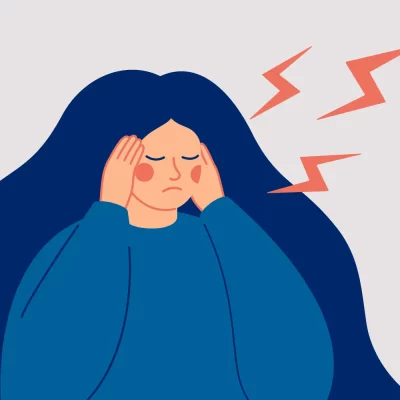Have you ever been in a good relationship but convinced yourself your partner would leave you because you argued? Do you need constant reassurance from friends that they aren’t mad at you and that you haven’t done anything wrong to them? If so, you may have an anxious attachment style.
Anxious attachment style is one of 3 insecure attachment styles which can impact relationships differently. Roughly 20% of the US population displays anxious attachment.
According to attachment theory, how we attach to others was learned as infants and throughout early childhood. And although it may feel like healing from an anxious attachment style and moving toward secure attachment is like climbing Mount Everest, it is entirely possible and attainable with knowledge, understanding, support, and effort.
As Part 2 of our 4-part series, Anxious Attachment Style, we will focus on how it was created in childhood, signs of anxious attachment, fundamental fears, and ways to grow toward secure attachment.
How is an Anxious Attachment Style created?
This particular attachment style is characterized by feelings of insecurity, deep fear, and clinginess in the presence of another person. Therefore, it is crucial to understand how anxious attachment is created so that individuals with this relationship dynamic can work towards healing from it.
Anxious attachment develops through inconsistent parenting during early child development. When primary caregivers provide inconsistent responses to their child’s needs or fail to meet them regularly, the child may develop insecure attachment.
For instance, if the primary caregiver does not respond quickly when the baby cries or fails to console them when they need it, then this could create doubt within the child’s mind about whether their parent will be there for them when needed. This inconsistency can also occur if a caregiver frequently withdraws attention even after providing some care or responds inconsistently between times they offer comfort and times they don’t.
Another factor contributing to developing anxious attachment as a child is a person who has emotionally unavailable parents. The lack of emotional availability could be due to various reasons, such as depression, substance abuse, or an overly busy lifestyle that doesn’t involve spending much time with the child.
When parents cannot provide emotional support and guidance, they may become more distant from their children, impacting the formation of emotional regulation and secure attachments.
Additionally, severe conflict in the home or between the parents that the child witnesses can lead to anxious attachment styles through feelings of rejection and insecurity surrounding relationships.
Traumatic experiences throughout life can also be a factor in developing an anxious attachment style. Trauma could range from physical or sexual abuse during childhood to neglectful parenting or other adverse life events. Childhood trauma has been linked to long-term issues in forming secure attachments. It tends to lead to feelings of insecurity and fear, resulting in anxiously attached children.
Understanding how anxious attachment is formed from childhood experiences can help individuals with this relationship dynamic recognize their formative experiences and take steps toward healing from them.
By exploring where these patterns may have come from, it is possible for someone with an anxious attachment style to work toward developing healthier and more secure relationships in their adult life.
Signs of Anxious Attachment
People with am anxious attachment style typically exhibit a few common signs and traits. For each person, anxious attachment can show in many ways. You can experience a variety of these characteristics or struggle with all of them. Think of attachment styles as a spectrum instead of a all or nothing system.
Here are some signs of anxious attachment:
- Excessive need for reassurance – People with an anxious attachment style tend to seek constant reassurance from their partners that they are loved and accepted. They may become overly dependent on the relationship, creating stress and frustration on both sides.
- Fear of abandonment – Those with this type of attachment often have difficulty setting boundaries or feeling secure in the relationship because they fear their partner may leave them at any moment.
- Insecurity in relationships – Anxious individuals usually feel insecure about themselves, often believing that they don’t deserve love or acceptance from anyone else and having difficulty trusting their partner’s intentions toward them. This belief makes it difficult to have healthy adult relationships.
- Preoccupation with thoughts about the relationship– Individuals prone to anxiety tend to overthink things, including worrying excessively about how their partner feels towards them or what could happen if something goes wrong. This tendency to overthink can lead to heightened stress and tension within close relationships and feelings of insecurity for both people involved.
- Difficulty expressing needs– People who struggle with insecurity can find it difficult to effectively express themselves and communicate when it comes to their needs or desires. This inability to communicate can make it challenging to work through conflicts healthily.
If you recognize any signs or traits from this list as areas in which you would like to grow, know that it is OK! Life is about learning and growing, as we are all constant works in progress. It is essential to understand that these feelings are normal and it is possible to improve these areas.
Thinking about why you may have these feelings can help you start the journey to make the necessary changes to turn an unhealthy connection into a healthy relationship.
Fundamental Fears of Anxious Attachment
An anxious attachment style is characterized by fear of abandonment, rejection, and loss. In relationships, those with anxious attachment styles may struggle to trust their partner or feel secure in their bond. They may be overly dependent on reassurance and validation from their partner, constantly seeking signs that they are still loved or accepted.
This dependence can lead to feelings of insecurity both in the relationship and within themselves. Their need for constant validation can result in frequent arguments or push-pull dynamics as they try to get their partner to prove their commitment.
They may also become prone to jealous behavior due to fears that someone else might take away the love or attention they receive from their partner. This type of behavior can create an environment of mistrust and tension between them, leading to a decline in communication and intimacy over time.
Those with an anxious attachment style are also likely to have a heightened sense of anxiety when discussing difficult topics in the relationship, such as money, kids, or anything that could cause conflict with the other person involved. This type of anxiety is rooted in the fear that these conversations could lead to rejection or abandonment, so it often causes individuals with anxious attachment to try and avoid them altogether.
Also, those with anxious attachment may struggle when dealing with change because they do not feel secure enough within the relationship to handle any potential outcome. Even if there is no real risk of ending up alone in the end, this fear can become overwhelming and prevent them from being able to take risks or make decisions necessary for progress and growth in life.
By understanding how the fears of an anxious attachment style manifest, we can begin taking steps towards learning how best to support them through whatever challenges arise during our relationships together.
Growing From an Anxious Attachment Style To a Secure Attachment Style
If you still need to read Part 1 of this series on Secure Attachment, check it out to understand what healthy attachment is and how it is attained. Having a base knowledge of the secure attachment style will help you better see the contrast between how secure attachment and insecure attachment affect self-worth and relationships differently.
The first step for those with an anxious attachment style is to become aware of your anxious tendencies and how they affect your relationships. Recognizing your anxious tendencies is done by reflecting on your past experiences with family, friends, or romantic partners that may have shaped how they currently feel about themselves in relationships.
Additionally, those who want to overcome anxious attachment should strive to practice self-care and build up their sense of self-worth to develop a healthier relationship with themselves, which directly correlates with how you see yourself in relationships.
It is also crucial for individuals seeking to grow from an anxious attachment style to seek out supportive people who can provide understanding and empathy when needed. Having someone you feel comfortable talking to about your feelings and experiences can help you work through any underlying issues causing distress in your life or relationships.
Finally, for anyone with anxious attachment, it is vital to practice patience and self-compassion as they grow from this relationship dynamic. It can take a lot of time and effort to overcome old patterns of thinking and behavior, but having patience and understanding with yourself during this process is key to creating lasting change.
Seek Help
With the help of a licensed therapist, healing anxious attachment and any of the insecure attachment styles is entirely possible. To overcome anxious attachment, individuals must be aware of their tendencies, practice self-care and build up self-worth, seek out supportive people, and practice patience and self-compassion.
Here at Makin Wellness, we are here to support your growth and healing concerning your attachment style, but we also specialize in many other areas. Call us or start here to make an appointment today to start your path to a secure attachment style.
For more information on attachment styles, here are some related posts to check out:
What is My Attachment Style? Part 1: Secure Attachment Style
What is My Attachment Style? Part 3: Avoidant Attachment Style
What is My Attachment Style? Part 4: Disorganized Attachment Style








